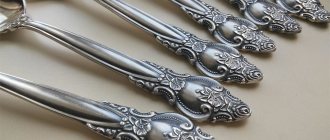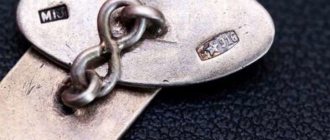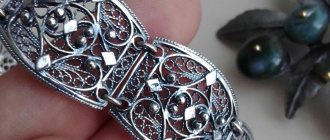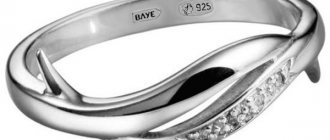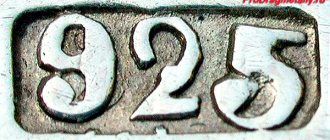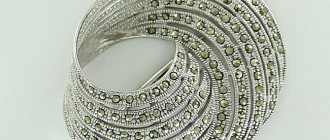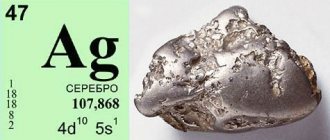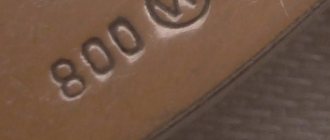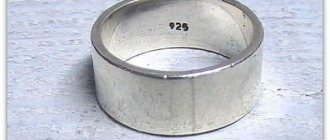The purity of silver, as well as the cost of products made from it, is determined by the ratio of the precious metal to the impurities contained in the alloy. The highest standard is 999, but such silver is practically not used to create jewelry. It is too soft and plastic and, therefore, products made from it will quickly lose their sophisticated appearance.
Attempts to find the ideal ratio of precious metal and impurities of various origins led to the emergence of 925 silver. This figure says that the product contains 92.5% silver, and the remaining 7.5% is an alloying metal (usually copper), which increases the performance characteristics and preserves the decorative value of the alloy.
The alloy 925 silver in its color and physical properties is almost no different from pure silver. The alloy of this sample has a silver-white color and high anti-corrosion, elastic and hard properties.
History of 925 silver
In ancient times, when there was no concept of what a silver sample was, people tried to understand what proportion of impurities was contained in pure silver. The different content of pure silver in products complicated trade relations not only within the country, but also in trade with other countries. In the Middle Ages, any master manufacturer of silver products could, at his personal discretion, put as much pure silver into the alloy as he wanted. That is, there was a need to introduce a single silver standard in the state for all manufactured silver products. The significance of the universal silver standard was enormous. The introduced silver standard made it possible to control the quality of silver products, both those produced within the country and silver imported from abroad, as well as to identify the dishonesty of the craftsman - the manufacturer. In ancient times, various systems for designating silver samples were used, which showed the quantitative content of pure silver in the alloy. These systems determined the degree of purity of the noble metal contained in the alloys. Therefore, the concept of silver standard appeared.
What is silver hallmark? Silver fineness is the quantitative content of noble metal in an alloy. The most common in the Middle Ages was the lot system for designating the standard of silver. In Tsarist Russia, the spool system was popular. Following this, the metric and carat systems appeared. Today in the world, including in Russia, Ukraine and Belarus, the metric system is widely used, which is considered the simplest and most convenient system to use. In the metric system, the hallmark of a noble metal (silver, gold, platinum) means the number of parts by mass (fractions) of pure metal in 1,000 parts by mass (fractions) of the alloy. This means that 925 silver alloy contains 92.5% pure silver and 7.5% copper, as well as various impurities.
Nowadays, when the physical and chemical properties of metals have already become well studied, today jewelers are making attempts to add other metals (platinum, germanium, zinc, silicon) to the composition of the 925 alloy in order to obtain new properties. Jewelers are thus trying to change the color, aesthetic properties of jewelry, and increase the strength and corrosion resistance of the silver-copper alloy. Currently, despite all attempts to improve the properties of silver, 925 silver-copper alloy is considered the ideal alloy for jewelry throughout the world . This is the most ideal alloy in terms of the ratio of silver and copper.
925 silver alloy is the very first silver standard that was provided in medieval England. Later it became widespread throughout Europe. The alloy of 925 silver was called sterling silver and was the very first hallmark of silver in history, the numerical value of which has survived to this day. Today, this silver standard is so widespread throughout the world that it is considered to be the global silver standard. And most of the silver jewelry all over the world is made from this alloy by jewelers.
The concept of sterling silver comes from the name of the German family of jewelers, the Easterlings, who once lived in the lands of Northern Germany. The Easterling family has always been famous for its honesty and integrity. In 1215, King Henry II of England commissioned this family to produce silver coins for England. The coins minted by order of the king turned out to be of excellent quality. The king's task was carried out so well that the Easterling family subsequently entered the history of silver, and the alloy from which silver coins were minted to this day means high quality silver.
Today, sterling silver, or simply sterling, is associated with the concept of coin silver. Despite the fact that in our time silver coins have almost ceased to be the monetary equivalent of payments in many countries, they still continue to be minted and perform a slightly different function. Today, 925 silver alloy is widely used for the manufacture of investment, collectible and commemorative coins.
What does "sterling silver" mean? Where did this name come from?
Archaeologists have found evidence that silver alloys were used as early as the third millennium BC. Medical and surgical instruments were made from it, because many people know that it has an antiseptic effect. The main quality of this metal is its plasticity, thanks to which any objects, as well as small parts, can be formed from it.
The name comes from the name of the alloy "Sterling", from which silver coins of one pound were made. The denomination meant the exact weight of 240 coins. If the weight of 240 coins was less, this indicated a fake or that the coins were quite old and therefore lost in weight.
Beginning in 1840, sterling silver became the most popular metal for cutlery in the United States and Europe. The number of factories grew very quickly to meet demand. At the height of this “craze”, 1870-1920, dinners in palaces and rich estates grew from three main dishes to ten, in order to demonstrate a variety of expensive products and serving items. Serving in those days could include many items: 5 forks, 6 spoons, 5 knives, as well as a napkin ring, goblet, cauldron, bowl and saucer.
Jewelry has also maintained its popularity and value for thousands of years. Sterling silver, unlike gold, was not very expensive, which was good news. When crafted with great skill and extraordinary artisan design, this amazing metal elevates any element added to it - from the humble amber to precious stones.
Using 925 sterling silver
925 sterling silver alloy is widely used for making jewelry and is considered one of the favorites among jewelers. Products made from 925 sterling silver are durable, do not deform when worn, and look good.
The tensile and plastic properties of one gram of 925 silver alloy are such that a thin wire several hundred meters long can be drawn from it. The unique malleable properties of this alloy make it possible to make various thin, weightless jewelry from it: rings, earrings and bracelets . Silver wire is used by jewelers as a material to create openwork filigree.
The photo below shows silver wire made from 925 sterling silver alloy.
Jewelry with fine filigree work is created from 925 silver alloy . Filigree is a very ancient type of jewelry art that has survived to this day. When decorating jewelry with filigree, a method of twisting silver or gold wire is used. To do this, two wires of precious metals are twisted together into one openwork thread. Then this thread is spread onto the surface of the jewelry and soldered. The work of creating filigree is very hard work, since the master jeweler has to process a large surface of the product with openwork thread made of precious metal. After the painstaking work of the master, the result is a beautiful openwork filigree. And in order for the filigree product to have an even more aesthetic appearance, the filigree is decorated with miniature balls or small grains smelted from silver and gold. Depending on the imagination of the master, filigree can be of various shapes: thick, thin, smooth or embossed. Filigree looks especially beautiful when it is combined with precious stones, decorated with crystal, mother-of-pearl or enamel.
Today, silver wire with the required diameter is obtained by heating a silver strand in order to give it the necessary softness. The silver rope is then pulled through several gradually tapering holes. This is how you get the wire of the desired section. Once the silver wire is ready, the jeweler begins to create a masterpiece of filigree jewelry.
The photo below shows a silver brooch made of high-grade 925 alloy. This silver jewelry has a rhodium plated finish and is made using the filigree technique. This filigree technique involved laying and soldering openwork silver wire and small silver balls onto a metal background.
Photo of an original filigree pendant - amulet, made of 925 sterling alloy. The presented jewelry has a protective rhodium coating. This piece has a green precious stone, peridot, embedded in it.
The interweaving of the finest silver threads in filigree work can have a strong resemblance to thin frost on windows. Depending on the imagination of the master, filigree products can have various designs, figures, patterns and ornaments.
Below in the photo you can see a silver fork made of 925 sterling silver alloy. The fork has a beautiful, elegant design with fancy shapes. This cutlery was made in the USA in the 1940s and is in excellent condition. The surface of the product shows almost noticeable signs of wear, in the form of small abrasions and scratches. This indicates that the owner of this fork treated this item with care. The fork is marked with the inscription “sterling”, which means that this product is made of high-grade 925 sterling silver.
Silverware in the home has always been associated with prosperity and wealth. Today, silverware is considered a collector's item. Even a small silver spoon made of 925 sterling alloy, if it is in the house, creates a pleasant impression of its owner. Pictured below is a small set of silver spoons and forks made from 925 sterling silver alloy.
Brand
Various silver samples - 925 and others - have their own mark, which allows you to estimate the percentage of impurities and identify the manufacturer. For example, a 925 ring will be stamped with the number 925 and the quality mark of the inspection organization that is engaged in official quality supervision. If there is no stamp or it does not contain a quality mark, and the seller cannot present a certificate, then most likely the product will be counterfeit.
Unfortunately, there is no single stamp sample. So, if you intend to buy a silver ring or something else made in a particular country, it is better to first familiarize yourself with the hallmarks and quality marks accepted there.
Rhodium plating of 925 silver items
In order for silver made from 925 sterling alloy to serve as long as possible without darkening or scratching, the surface of the silver is coated with a thin layer of white rhodium. Rhodium is a platinum group metal that, when applied to silver items, gives the items a bright white shine. Rhodium coating protects products from corrosion, and therefore from destruction. Such rhodium plated products can be stored for a very long time. If you compare ordinary non-rhodium-plated 925 sterling silver with silver products of the same standard, but coated with a layer of rhodium, then characteristic differences will immediately catch your eye. Products made from rhodium-plated silver, in comparison with ordinary uncoated silver, look much brighter in color.
The picture shows a 925 sterling silver rhodium plated chain.
There are people who prefer to wear jewelry without rhodium plating. They believe that wearing pure silver with a slight blackening is much more pleasant than silver plated with rhodium, which gives an absolute white color.
These photos show a 925 sterling silver oval hallmarked chain. This silver jewelry was made in Italy. The presented jewelry is not rhodium plated. The product has slight blackening in places. This means that it has been worn. If this silver item is slightly cleaned, it will look even better. Although some connoisseurs of silver may be quite happy with such darkening of the metal. Some silver jewelry lovers find that slightly blackened silver looks more attractive than items with sparkling metal.
Türkiye
Turkish silver is widely known for its quality products, variety of shapes, fine workmanship and intricacy. The jewelry craftsmanship of this country has rich traditions, and the craftsmen are able to make any product, be it a men's chain, a woman's silver ring or silver cutlery (teaspoons, Turks, trays).
The most commonly used metal in work is 925 grade metal. Less commonly, 960-grade metal, products from which will be much more expensive.
Local products can be purchased at relatively low prices. However, there is a risk of buying a fake in Turkey. Therefore, when making a transaction, it is recommended to ask sellers for quality certificates.
How to store 925 silver?
Humidity is one of the worst culprits in tarnishing silver. Store your jewelry in a jewelry box or other locked place and add special sachets of humectant agents to these areas. They absorb moisture and protect your jewelry.
If you don't wear your jewelry or store it for a long time, there are other ways to prevent it from tarnishing. Store them in jewelry cloth or ziplock bags to keep them out of direct sunlight.
One of the most harmful chemicals to sterling silver is chlorine or bleach. Never wear silver rings or jewelry while swimming in a pool or cleaning with bleach.
Salt is another important risk factor for silver corrosion. Swimming in sea water is contraindicated for silver!
Perfume and hairspray can damage your favorite jewelry. If you're getting ready for a party, it's best to apply perfume and hairspray first. Wait for it to dry before putting on your jewelry.
Cleaning 925 silver
Preventing tarnishing of silver items involves wiping the item monthly with a flannel, suede cloth or felt. The use of abrasive materials is strictly not recommended, because they can damage the surface of the metal, and in the future it can only be cleaned by polishing, often exclusively in jewelry workshops. To do this, the silver item is first soaked in soapy water, thoroughly rinsed, dried, and then polished with flannel or suede. You should choose non-metallic utensils for cleaning. Specialized cleaning products have also been developed for silver, which can be purchased in jewelry stores.
In addition to cleaning silver items with special products, there are also several alternative cleaning methods. Before cleaning any of them, you should soak the product in soapy water and rinse well. You can find out more about ways to clean silver at home in our next article.
Prices
Let's figure out how much 925 silver costs. The starting price per 1 gram is fixed, does not depend on the place of extraction and is set in England. However, there is no single cost for all products.
On the international market, the cost of 1 gram of 925 silver is constantly changing under the influence of stock quotes, which depend on:
- on world currency rates;
- from interest rates of the world's central banks;
- from the raw material needs of jewelry manufacturers.
Based on these indicators, the Central Bank of Russia calculates new prices every weekday. The best price per gram in 2021 was 34.72 rubles. As of May, fluctuations from 29.96 to 31.55 rubles were recorded, and from May 31, 2017, the Central Bank predicts a further increase in prices.
Directly on the consumer market, the cost of 925 silver also depends on the composition of the products discussed above, on the place and form of their sale.
Precious metal can be purchased in the following form:
- ingots;
- scrap;
- coins;
- decorations;
- silver plate;
- Houseware.
Metal ingots of the highest purity 999.9 are the best investment. Scrap 925 silver has the lowest price, since it always needs further processing and the buyer will probably melt it. The value of coins depends not only on their content, but also on their rarity and antiquity. The cost of 925 silver depends on various reasons. For example, the price at which you can buy a silver ring depends on its weight, manufacturing technique, the presence of inserts and the name of the manufacturer.
The method and place of sale also matters. Today in Russia the cost of one gram is as follows:
- pawnshop – 18–28 rubles per gram;
- purchase – 26–31 rubles;
- jewelry stores - from 40 rubles and above.
This difference in prices for 1 gram of 925 silver is determined by the characteristics of the sale of goods. Buying silver purchases a product without the possibility of return. Specialty stores include the cost of creating the item in the final price.
The price of 925 silver is steadily growing, since according to geological reports, at a steady rate of mining, its reserves will last for a maximum of half a century, and there is nothing to replace the precious metal yet.
Silver-plated jewelry in the catalog of the SeViMi online store
cubic zirconia
Buy!
Add to wishlist
Close
Earrings with cubic zirkonia Radiance
37.00 rub.
Buy!
Add to wishlist
Close
Laconic Silver Congo Earrings
25.00 rub.
Buy!
Add to wishlist
Close
Romantic necklace Two hearts
35.00 rub.
Buy!
Add to wishlist
Close
Chain with armor faceted silver-colored weaving
28.00 rub.
Buy!
Add to wishlist
Close
Thin chain with faceted armor weave
27.00 rub.
Buy!
Add to wishlist
Close
Thin chain necklace with double diamond braid
27.00 rub.
GO TO CATALOG
